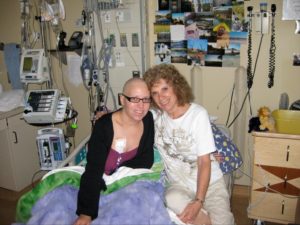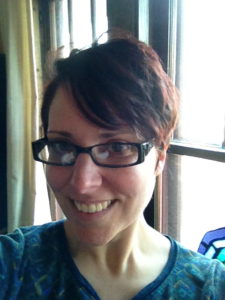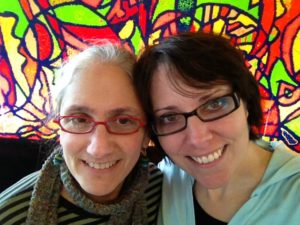Are You My Mother-in-Marrow? Two Years After My Transplant
I have a blood brother.
We could have made our oath to each other with a simple prick of our fingers, I suppose, but I don’t like to do anything halfway.
In December 2010 I was diagnosed with Acute Myelogenous Leukemia. All-told it took over 35 blood and platelet transfusions to keep me alive during my treatment. I had many fluid infusions, too. Then, seeking a cure for the AML, my doctors searched in the Be the Match registry for an unrelated adult donor. Only 50% of the patients who need a transplant are able to find a match, but thankfully they found one for me. I don’t know his name. Early on we nicknamed him “Valinor,” but more on that in another post. I don’t know where he lives. I only know that he is in another country, around 34-years-old today and that he said “yes” when he had the opportunity to help try to save a stranger’s life. I hope someday I’ll know more. At my appointment two days from now I get to fill out the paperwork requesting to contact him. Then I have to wait for him to say “yes” again.
He donated his marrow in an outpatient surgical procedure, under anesthesia. Other donors have told me when they woke up it felt like they’d fallen hard on the ice, that they were sore for a few days, and that before and after the procedure they were treated like heroes. When I received my new marrow late at night on May 12, 2011 it had been flown across water, put into a transfusion bag, infused into my veins, and then eventually found its way into my bones and set up shop where it now makes the blood that flows through my body.
Closing in on midnight, I waited for my new marrow in my hospital room with my rabbi, two very close friends, and my partner. We discussed the moment from the Torah when Abel’s bloods cried out from the ground. Bloods – plural. We said a misheberach, a prayer for healing, for my donor. We also said a misheberach for me. Around midnight the nurses came in and began the transfusion process. Heavily medicated, I soon fell asleep to the sound of some of the people I love most in the world talking over me.
My transfusion history means there are over 35 people, most of whom probably live in or near the Twin Cities, whose blood has flowed through my veins. That kind of changes the way one sees the other people in the grocery store. Are you A-? Did you donate blood during those years?
See what I mean?
Most dramatically, though, each day for the past nearly two years I have thought about my marrow donor – Valinor – and the bloods we now share.
This year the anniversary of my transplant – or transplantaversary – coincides with Mother’s Day. In thinking about what story from among all of the stories of my ongoing BMT journey I wanted to share right now, I started thinking about my donor’s mother. All this time I have been entirely focused on Valinor and what it might be like to meet him someday. I have been careful not to personify him too much. I realize that just because we were born a world apart with very similar DNA there is no reason to think he’s a progressive Jew who thinks like me. Only because of Mother’s Day did I start wondering about the rest of his family. What mother raised this person who grew up, joined the registry, and said “Yes?” What might she be like? Will I ever get to meet her? Will my mother ever get to meet her?
As a Jewish educator I cannot count how many times I’ve facilitated discussions asking similar questions about Moses’s family. Moses had some pretty outstanding parental-types, I think. Two mothers who were courageous, rebellious, and interested in justice – one a birth mother, one an adoptive mother. And while we don’t know much about Amram, Moses’s birth father, Moses also had two outstanding father figures in Amram and Moses’s father-in-law Yitro. Moses had siblings who were significantly older guiding him, too.
As my mind wandered down that path, reflecting on the four people who parented Moses, I caught myself and laughed. I had been imagining my donor’s mother, but it’s also possible that he doesn’t have one. He might have two dads. What if my donor has no relationship at all with the woman whose egg helped create the DNA in our blood? His family could be configured like any family. His family could be just like mine: a mother with whom I am close and a father with whom I have nearly no relationship. Or it could be as traditional as Moses’s family. Suddenly there are so many possibilities, but this I still know: Whoever raised him, whoever the adults were who influenced him, they did something right, because when he had an opportunity to save the life of a complete stranger, he did.
When he was asked, “Are you your blood-sister’s keeper?” He didn’t respond, “What sister?” He said, “Yes.”
When I was in the hospital, if there had been a blood-is-thicker-than-water policy that only immediate family and legally-married spouses were allowed in my room, I would have been alone for most of my stay. Added together, I have spent months in the hospital. My mom lives and works miles away in New Mexico and I am her only child. Yet, I was rarely alone when receiving chemo and never alone for more than a few minutes during the five weeks of transplant. My family was there. My partner. My friends. Her friends. Her sister and her sister’s partner.
It’s irrelevant, really, whether blood or water is thicker. The bone marrow transplant journey shines an extraordinary light on how much we need them both.
On May 12th this year many people in the United States will be celebrating mothers and motherhood. I will also be celebrating with my mother, and honoring all of the people who have raised and mothered me. I will enjoy reflecting on all of the opportunities I have had to guide and mother others in my life and look forward to continuing to do so. Primarily, though I will be thinking of my donor Valinor and his family, and I will be celebrating my family – all of them – and looking forward to the day when we all may meet.




